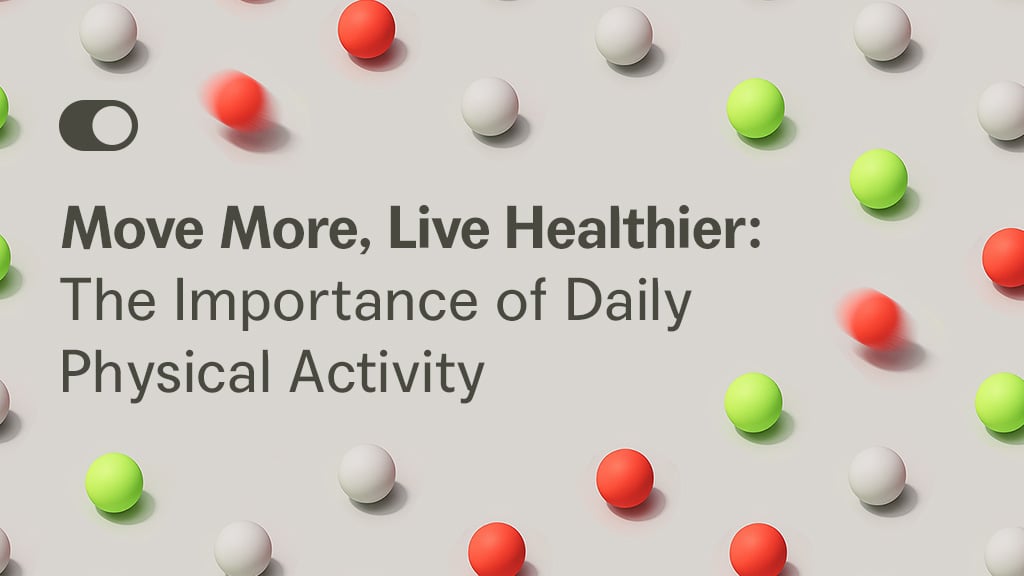
Move More, Live Healthier: The Importance of Daily Physical Activity
Check out our AI-generated audio summary:
We all know that being active does a body good. Toned arms and well-fitting jeans aside, engaging in regular exercise positively impacts one’s physical and mental health, and overall well-being in profound ways. According to the Centers for Disease Control and Prevention (CDC), “Regular physical activity is one of the most important things you can do for your health.” In fact, incorporating just 30 minutes of physical activity a day can work wonders—from helping fend off the flu and managing weight to reducing stress and improving sleep. Below, learn about the various long-term benefits of movement, plus get practical tips on how to establish a routine and develop sustainable fitness habits.

Improved Heart Health and Reduced Risk of Illness
You don’t need to be a serious runner or live in the gym to reap the health rewards of physical-activity routines. As with most things in life, small steps and consistency are key (more on that, later). When you stick with a routine, you’ll enjoy significant health benefits including:
A Happier Heart
Engaging in a minimum of 30 minutes of moderate-intensity cardio every day (or 150 minutes a week) works wonders for cardiovascular health: reduced risk of heart attack and heart disease, improved cholesterol levels, and lower blood pressure.
Weight Management
Regular exercise can help with your weight management goals, which minimizes strain on the heart and is integral to overall health.
Stronger Bones and Muscles
Routinely lifting weights (twice weekly), and engaging in resistance and weight-bearing exercises (e.g. walking, hiking, stair-climbing, and dancing) help protect and strengthen joints and muscles, and prevent bone density loss that occurs with aging.
Flu Fighter
Several respected studies show that regular physical activity can lessen the impact of the flu and colds; expect milder symptoms and quicker recovery times. With flu season just around the corner, consider this your motivation to keep up—or start—that daily exercise routine.
Reduced Risk of Chronic Diseases
Maintaining regular physical activity helps reduce the risk of stroke, developing type 2 diabetes, and even certain cancers like breast and colon.

Less Stress, Lighter Mood, More Energy
Along with benefitting your body, regular movement can also calm your mind and boost your mood and energy. Why? Moderate physical activity helps lower cortisol levels, the primary stress hormone that can cause weight gain, fatigue, and other unpleasant effects. Regulating your stress response helps you feel calmer, less anxious, and build resilience.
Exercise is also a potent stress-reliever because it releases feel-good endorphins —these natural chemicals lift mood (hey, runner’s high) and promote feelings of happiness. Additionally, they increase energy, sharpen focus, and enhance cognitive function. More ways regular movement can improve your quality of life:
Get Better Sleep
Get moving and fall asleep faster, sleep more deeply, and experience less insomnia.
De-Stress in Healthy Ways
Exercise is a positive distraction from worries, negative thoughts, and sadness—a better alternative than turning to substances or other harmful behaviors.
Build Confidence
Feeling stronger, healthier, and pushing through tough workouts, provides a sense of accomplishment, building confidence and self-esteem, and improving body image.
Socialize More
Fitness classes, sports teams, or walking/running clubs offer opportunities to be around others, fostering a sense of community and combatting feelings of isolation or loneliness.
Boost Joy
With more energy, improved fitness, and better mood, participating in everyday activities (and even stepping outside of comfort zones) becomes more fun and joyful.

Get Started with These Active Lifestyle Tips
No matter how busy you are, incorporating exercise into a daily schedule doesn’t have to be time-consuming or complicated. By making little adjustments, shifting your mindset, and prioritizing your fitness, you’re laying a foundation for a forever healthy lifestyle. Start here:
Set Manageable Goals
Be clear about what you want to achieve and how you plan to achieve it. Writing SMART goals can be helpful: Make sure every goal is Specific, Measurable, Achievable, Relevant, and Timebound.
Start Small, Be Consistent
Forget about aiming for perfection, just move your body. Can’t make the spin class? It’s OK—fit in 10-minute workouts where you can throughout the day. Those minutes add up, make a difference, and help build a sustainable habit.
Find Activities You Like
Choose physical activities you know you enjoy (skip things you dread) and experiment with new workouts to keep things fresh and fun.
Schedule Physical Activity
Treat daily movement like you would any important appointment (because it is). Block out time in your calendar for workouts and don’t skip them.
Be Flexible and Adaptable
Life happens, so if something comes up and you need to miss a day, it doesn’t have to derail you—just get back to it the next day.
Take Rest Days
Make sure to set aside rest days, allowing your body time to recover. This is important to prevent both injury and burnout.

Exercise Motivation Techniques
You wouldn’t be human if the commitment to your daily routine didn’t waver from time to time. When that internal tug of war (power walk vs. couch, remote, and ice-cream pint) strikes, there are things you can do in the moment (and as part of your ongoing mindset) to push through it. Such as? Remember why you’re working out in the first place, reflect on your SMART goals, and all the good you’re doing for your overall health. Always keep track of your physical activity (via app, journal, or fitness tracker) and celebrate your progress and milestones—nothing is too small. Relishing the wins is a huge motivator. Now, let’s go!
Have questions about developing your own daily fitness routine? Connect with a certified Health or Fitness Coach today.